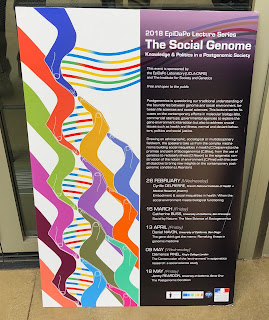Week 8: Nanotechnology and Art
Before this week’s lectures, I have always thought that nanotechnology is a newly innovated branch of technology, perhaps even more recent than biotechnology. However, as Professor Gimzewski stated, nanotechnology has appeared long before scientists could truly comprehend the workings and characteristics of atoms (2012).
 |
| Lycurgus Cup |
One of the earliest examples of nanotechnology could be found in the Lycurgus cup, which dated from the late Roman civilization. According to the British Museum, Lycurgus cup is a drinking cup that portrays various scenes of King Lycurgus’s death (2017). Undoubtedly, the Romans wanted the cup to be an artistic piece or memorabilia for the next generation. However, its color-changing properties intrigue the scientists. The cup appears jade green when lit from the front but blood-red when lit from behind (Merali, 2013). After scrutinizing the cup’s broken fragments under a microscope, the researchers found that the glass is filled with tiny nanoparticles of silver and gold, whose electrons would vibrate and alter the color when in contact with light (Freestone et al., 2007). This manipulation of nanoparticles is what scientists today considered as nanotechnology.
 |
| Stained-glass image of St. George from the early 15th century |
Another example of nanotechnology in the form of art is the stained glass that we usually see in old churches. Medieval artists discovered that adding gold chloride particles to molten glass would result in a red tint, and adding silver nitrate particles turned the glass yellow (Chan, 2018). This technique has resulted in some of the world’s most spectacular stained glass windows of all time.
 |
| Nanomedicine |
It is unclear to me whether the artists use nanoparticles to create beautiful art or they use art to document scientific applications. Nevertheless, it is undeniable that the cup and the stained glass are the ultimate proofs that art and science are truly inseparable. One could not flourish without the other.
Nanotechnology and art together offer untapped potential to better our ways of living, whether it is medically or socially. Perhaps, it could even be the answer to most of our problems today.
Work Cited
Chan, Chi. “From Nanotech to Nanoscience.” Science History. 2008. Retrieved from https://www.sciencehistory.org/distillations/magazine/from-nanotech-to-nanoscience
Chan, Chi. Stained-glass image of St. George from the early 15th century. 2008. Photograph. 25 May 2018. Retrieved from https://www.sciencehistory.org/distillations/magazine/from-nanotech-to-nanoscience
Merali, Zeeya. Lycurgus Cup. Sep 2013. Photograph. 25 May 2018. Retrieved from
https://www.smithsonianmag.com/history/this-1600-year-old-goblet-shows-that-the-romans-were-nanotechnology-pioneers-787224/
Merali, Zeeya. “This 1,600-Year-Old Goblet Shows that the Romans Were Nanotechnology Pioneers.” Smithsonian Magazine. Sep 2013. Retrieved from
https://www.smithsonianmag.com/history/this-1600-year-old-goblet-shows-that-the-romans-were-nanotechnology-pioneers-787224/
Freestone, I., Meeks, N., Sax, M., & Higgit, C. “The Lycurgus Cup: A Roman Nanotechnology.” Gold Bulletin, vol. 40, issue 4, 2007. Retreived from http://master-mcn.u-strasbg.fr/wp-content/uploads/2015/09/lycurgus.pdf
Gimzewski, James. “Nanotech.” Cole UC online. Youtube, 21 May 2012. Web. 25 May 2018.
The British Museum. The Lycurgus Cup. 2007. Retrieved from http://www.british museum.org/research/collection_online/collection_object_details.aspx?objectId=61219&partId=1&searchText=lycurgus+cup&page=1
Zhu, G., Mei, L., & Tan, W. Nanomedicine. 1 Aug 2014. Photograph. 25 May 2018. Retrieved from https://www.the-scientist.com/?articles.view/articleNo/40598/title/Nanomedicine/



I am amazed that art from the Roman civilization was able to include the intricate science of nanotechnology! This is a great example of the overlap between art and science.
ReplyDeleteHi! I liked how you decided to focus on how nanotechnology has been around for a longer time period than most people would assume. It's interesting that you used the phrase "document scientific applications" because I normally would not think of art as a documentation of science, but rather of science as a documentation of art.
ReplyDelete